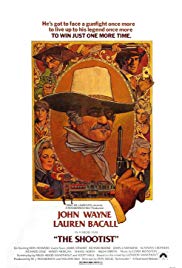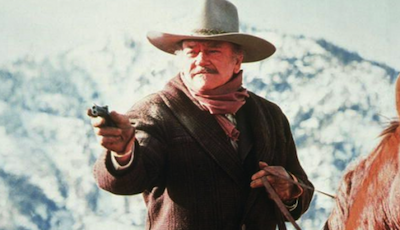QUICK DISCUSSION QUESTION:
As the initiate in the film, Gillom learns a lot from Books. What was the most important thing that he learned?
Suggested Response:
Gillom was skilled with a gun before he met Books. This was shown during the target practice scene. Gillom understands what Books is doing by entering the saloon and encountering the men from his past. When Gillom enters the bar, Books lies dying, brought down by a cheap shot. Although Gillom has grown fond of the old man and retaliates against the bartender who shot Books in the back, Gillom sees that the ethic of the gunfighter represented by Books is no longer viable. By leaving the bar without taking any credit for killing the man who shot Books, Gillom ends the pattern of gunfighter competition. This signals the end of the gunfighter era and the myth of the Western hero.
1. See Discussion Questions for Use With any Film that is a Work of Fiction.
THEME
See the Quick Discussion Question.
[The following question is suitable for students who have been presented with the information in TWM’s Handout Myths of the Western Genre — Are American Men Just a Bunch of Cowboys?.]
2. Is J.B. Books a true hero of the Western genre, an American Adam?
Suggested Response:
The following would be components of a strong response to this question: a) Books is intelligent and experienced; he is an expert shootist; b) Books was once physically fit but he is no longer; in fact, he is dying of cancer, but he is strong enough for the final confrontation; c) Books has enough wealth to live as he chooses; he has no trouble paying for his room or his medical care; d) Books is a member of mainstream culture; e) Books is single; f) Books is definitely an outsider in Carson City and in the new century. Books is seen by Gillom and other characters as a representative of the authority of the frontier society, however, only vestiges of this society exist. Books is a wounded and dying lion. Most characters want to use him for their own purposes. See Suggested Response to Question #4 below.
3. What scenes from the film indicate that Books is an anachronism whose time has and come and gone?
Suggested Response:
Books rides into town and looks out of place with trolleys, early automobiles, churches and crowded streets with newspapers sold on the corner. The creamery truck driver tells Books to get out of the way and the boy with him urges the driver on with a disrespectful comment that the old gunman is not worth the trouble. The sheriff, at first nervous about Books’ presence, becomes animated and gleeful at the idea that the old gunfighter is dying.
4. Which characters in the film are willing to exploit Books or to use him for their own purposes?
Suggested Response:
Almost all of them: the livery stable owner wants to profit from Books’ horse and saddle; the mortician wants to make money exhibiting Books’ body after he dies; the barber sweeps up some of his hair to sell; Gillom tries to swindle a few dollars from the sale of Books’ horse; Books’ woman friend from the past tries to get him to marry her; the journalist wants Books to assist in a novel he is writing; the men who want to kill him are eager to earn a reputation for having taken down a famous gunfighter; and finally, Bond Rogers wants to save his soul. Note that as the film progresses, Bond relents and accepts Books on his own terms while Gillom comes to admire and love the old gunfighter. An important exception is Books’ old friend the doctor; he doesn’t appear to have any agenda of his own in his relations with Book.
5. This film is often seen as a metaphor for the death of the Old West in general. To many, the film is seen as the Western genre acknowledging its own limits in terms of time. Do you agree or disagree with these views? Justify your answer.
Suggested Response:
There is a lot to be said for both of these ideas. Books is clearly an anachronism: he does not fit into the beginning of the 20th century, just as the Old West died out at about the same time. Just like the Queen who, Books learns from the newspaper, has just died, the time of the Western hero has passed. Both gunfighters and queens are from another era. In terms of Western film, once the gun-toting good guy no longer matters, what will the stories be about?
6. Does American culture still respect the violence that is shown in this film?
Suggested Response:
Although violent Western is no longer a popular film genre, many films have similar stories and similar characters who use violence to solve problems. Students will be able to come up with many titles to support this position, including the gangster films and the “gangsta rappers”..
7. What was J.B. Books’ creed and is it suitable for modern times? Is it ethical?
Suggested Response:
Books tells Gillom, “I won’t be wronged, I won’t be insulted, I won’t be laid a hand on. I don’t do these things to other people; I require the same of them.” Books is willing to kill and he accepts the fact that someone may kill him. This seems attractive on the surface. However, it is not ethical because it involves killing someone in circumstances in which the killing is not absolutely necessary. A good response will point out that the flaws in the gunfighters’ code include: (1) it overreacts and escalates minor disputes into life and death situations; (2) in a civilized society, the state is the institution which administers justice and which has a monopoly on violence; and (3) what it means to be wronged can be different things to different people; in modern society, Books’ “morality” would lead to chaos..
CHARACTERIZATION
8. There is more to Books’ personality than just being a gunfighter. What incidents in the film show this? Do you think that Books was always like this or did the prospect of death from cancer make him see life in a different way?
Suggested Response:
Examples of actions which suggest the complexity of Books’ character are: Books talks Bond into enjoying a ride in the countryside with him. He spends time with Gillom as a father might. When Gillom tries to profit from the sale of Books’ horse, Books symbolically takes Gillom “to the shed” where he chastises the boy for his dishonor. Books is fatherly in this encounter, showing affection and disappointment rather than anger. Books is at first pleased to see and then hurt by a woman friend who comes to visit. He tells Bond he is afraid of dying. He passes his cushion on to the old trolley driver and tells a young woman he hopes she finds the right gentleman. As to the second part of the question, there is no once correct answer.
9. Does it appear to you that Books wanted to die with his boots on in order to keep the legend alive and to keep his fading dignity? Justify your answer.
Suggested Response:
Many responses are valid. One is that Books was, in a way, committing suicide. The doctor suggested that if he were a man of physical courage, like Books, he wouldn’t want to die the slow agonizing death from cancer that would have been Books’ fate had he not died by the gun. Books took care of all of his business prior to entering the saloon and said his goodbyes. Students may see Books as doing the right thing in facing down the men in the saloon or they may feel he needed to die this way in order to save face or to avoid dying in pain. In any case, it is clear that he knew he would likely die in the encounter.
10. Which characters changed through the course of the movie?
Suggested Response:
As to Gillom, see response to Coming of Age Question #1, below. His mother also changed her attitude toward Books and became willing to accept the old gunfighter on his own terms. Books also changes in that he accepts the inevitability of his death. However, he does not change in that he still meets all that life offers him, including his death, on his own terms.



